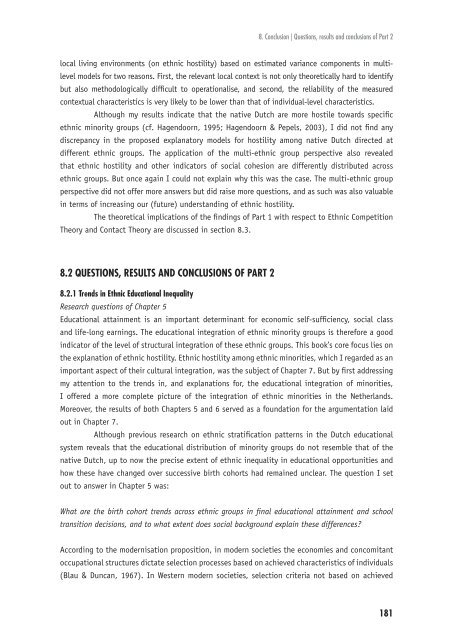Ethnic Hostility among Ethnic Majority and Minority Groups
Ethnic Hostility among Ethnic Majority and Minority Groups
Ethnic Hostility among Ethnic Majority and Minority Groups
You also want an ePaper? Increase the reach of your titles
YUMPU automatically turns print PDFs into web optimized ePapers that Google loves.
local living environments (on ethnic hostility) based on estimated variance components in multilevel<br />
models for two reasons. First, the relevant local context is not only theoretically hard to identify<br />
but also methodologically diffi cult to operationalise, <strong>and</strong> second, the reliability of the measured<br />
contextual characteristics is very likely to be lower than that of individual-level characteristics.<br />
Although my results indicate that the native Dutch are more hostile towards specifi c<br />
ethnic minority groups (cf. Hagendoorn, 1995; Hagendoorn & Pepels, 2003), I did not fi nd any<br />
discrepancy in the proposed explanatory models for hostility <strong>among</strong> native Dutch directed at<br />
different ethnic groups. The application of the multi-ethnic group perspective also revealed<br />
that ethnic hostility <strong>and</strong> other indicators of social cohesion are differently distributed across<br />
ethnic groups. But once again I could not explain why this was the case. The multi-ethnic group<br />
perspective did not offer more answers but did raise more questions, <strong>and</strong> as such was also valuable<br />
in terms of increasing our (future) underst<strong>and</strong>ing of ethnic hostility.<br />
The theoretical implications of the fi ndings of Part 1 with respect to <strong>Ethnic</strong> Competition<br />
Theory <strong>and</strong> Contact Theory are discussed in section 8.3.<br />
8.2 QUESTIONS, RESULTS AND CONCLUSIONS OF PART 2<br />
8. Conclusion | Questions, results <strong>and</strong> conclusions of Part 2<br />
8.2.1 Trends in <strong>Ethnic</strong> Educational Inequality<br />
Research questions of Chapter 5<br />
Educational attainment is an important determinant for economic self-suffi ciency, social class<br />
<strong>and</strong> life-long earnings. The educational integration of ethnic minority groups is therefore a good<br />
indicator of the level of structural integration of these ethnic groups. This book’s core focus lies on<br />
the explanation of ethnic hostility. <strong>Ethnic</strong> hostility <strong>among</strong> ethnic minorities, which I regarded as an<br />
important aspect of their cultural integration, was the subject of Chapter 7. But by fi rst addressing<br />
my attention to the trends in, <strong>and</strong> explanations for, the educational integration of minorities,<br />
I offered a more complete picture of the integration of ethnic minorities in the Netherl<strong>and</strong>s.<br />
Moreover, the results of both Chapters 5 <strong>and</strong> 6 served as a foundation for the argumentation laid<br />
out in Chapter 7.<br />
Although previous research on ethnic stratifi cation patterns in the Dutch educational<br />
system reveals that the educational distribution of minority groups do not resemble that of the<br />
native Dutch, up to now the precise extent of ethnic inequality in educational opportunities <strong>and</strong><br />
how these have changed over successive birth cohorts had remained unclear. The question I set<br />
out to answer in Chapter 5 was:<br />
What are the birth cohort trends across ethnic groups in fi nal educational attainment <strong>and</strong> school<br />
transition decisions, <strong>and</strong> to what extent does social background explain these differences?<br />
According to the modernisation proposition, in modern societies the economies <strong>and</strong> concomitant<br />
occupational structures dictate selection processes based on achieved characteristics of individuals<br />
(Blau & Duncan, 1967). In Western modern societies, selection criteria not based on achieved<br />
181












